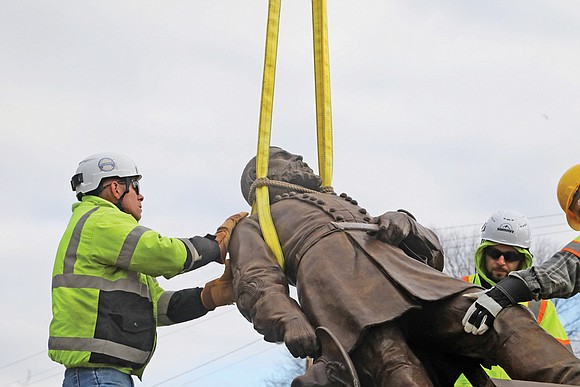City’s last Confederate statue removed
Holly M. Rodriguez | 12/15/2022, 6 p.m.

A statue commemorating the death of Confederate Gen. Ambrose Powell (A.P.) Hill was removed on Monday, from Hermitage Road and West Laburnum Avenue where it had stood for 120 years.
Gen. Hill was the last Confederate statue in Richmond, after being caught up in litigation from indirect descendants who argued the statue should not be removed because the general’s remains were buried there. But after Richmond Circuit Court Judge David E. Cheek Sr. denied the distant relatives’ request for a stay that would have halted the city’s ability to proceed while they appealed the Oct. 25 ruling, the decision ensured the removal could proceed. The relatives’ appeal for a stay was refused Dec. 8.
A.P. Hill’s remains were released to the distant relatives, who plan to bury him at a family plot in Culpeper County.
“We get into this work to right historic wrongs and that was a wrong — erecting those monuments in the beginning — and now it has been righted,” Richmond Mayor Levar M. Stoney said at the site on Monday as disassembly was underway.
John Hill, who said he is a descendant of A.P. Hill and one of the complainants in the litigation with the city, said he drove eight hours from Ohio to Richmond to oversee the removal and handling of his ancestor’s remains.
“The statue should never have come down,” Mr. Hill said, speaking to reporters at the site on Monday. “The Confederacy was not a fight for slavery — they were fighting for state’s rights, and against tariffs.”
Another point of contention for the descendants is possession of the statue itself, Mr. Hill said. The former Confederate general’s remains were believed to have been buried in or below the pedestal the statue sat on. Retrieved on Tuesday, Dec. 13, the remains were released to the family.
The statue and the pedestal remain in the possession of the City of Richmond. Mr. Hill said the statue and pedestal are his ancestor’s headstone, and the complainants want to keep the remains and the statue together. Mr. Hill said he plans to file litigation in court for possession.
Dozens of spectators cheered on Monday as the statue was removed and placed on tires that lay on a nearby tow truck. Petula Burks, strategic communications director for the city, said the overall structure had to be dismantled in sections, and each section of the statue carefully examined and moved, due to the size of the structure and the uncertainty about where A.P. Hill’s remains are buried within it. One piece of the structure that was moved, for example, was 1,000 pounds.
One of the onlookers cheering was Amanda Lynch, a Henrico resident and former teacher for Richmond Public Schools. She said her presence there was a full circle moment for her family.
“My third great-grandmother, Mary Jane Palmer Harris, had four children by M.B. Palmer, a local plantation owner,” she said. The removal of the last statue, she said, has been a long time coming, and she has been observing as every statue came down.
Ms. Lynch’s daughter, Ava Holloway, performed with another ballerina at the site of Confederate Gen. Robert E. Lee’s monument two years ago.
Councilwoman Anne-Frances Lambert, 3rd District, shared Ms. Lynch’s full-circle sentiment.
“My fourth great-grandfather, Julius Edmund Lambert, was a Confederate soldier,” she said. “I’m ecstatic that I am here during a time when the last of these monuments comes down because it creates an opportunity to bridge our community.”
Beyond the cultural controversy over what the statue represented, motorists and pedestrian activity around the base intersection long was a concern for residents of the Rosedale neighborhood near Linwood Holton Elementary School.
Liz Turner, past president of the Rosedale Civic Association and a member of the Richmond Crusade for Voters, lives a block away from the former monument site. She said she has seen too many accidents happen in the intersection.
“If his ancestors are really concerned with putting him to rest, then they should want him away from here because this man has not rested in peace since he was buried here,” she said. “I am also deliriously happy to see that statue go, because it represents the end of a shameful part of our history.”
Another spectator stopped by to watch after dropping her son off at school. “I stopped to watch this because it means no more celebrating slavery and all of its torture,” Joy Shaw said. “My ancestors did not live to see this day but I did, and I am recording this as an important day in my history.”
Jeremy M. Lazarus contributed to this report.







